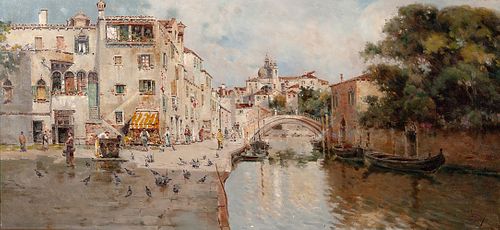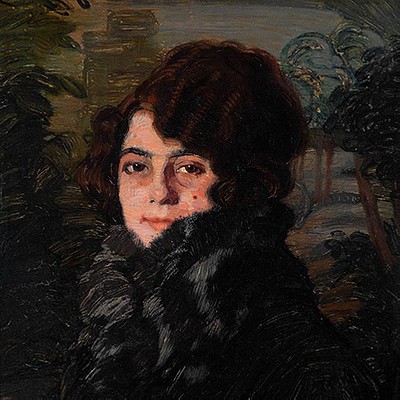ANTONIO REYNA MANESCAU (Coín, Málaga, 1859 - Rome, 1937). Venice Canal. Oil on canvas.
Lot 28
About Seller
Setdart Auction House
Carrer Aragó 346
Barcelona
Spain
Setdart Subastas was born in 2004 and is currently the first online art auction in Spain with solidity, prestige and reliability guaranteed by our more than 60,000 users. Setdart has a young, dynamic and enterprising team ready to successfully manage the purchase and sale of art works through custom...Read more
Estimate:
EUR€18,000 - EUR€20,000
$19,565.22 - $21,739.13
Absentee vs Live bid
Two ways to bid:
- Leave a max absentee bid and the platform will bid on your behalf up to your maximum bid during the live auction.
- Bid live during the auction and your bids will be submitted real-time to the auctioneer.
Bid Increments
| Price | Bid Increment |
|---|---|
| EUR€0 | EUR€10 |
| EUR€200 | EUR€25 |
| EUR€500 | EUR€50 |
| EUR€1,000 | EUR€100 |
| EUR€3,000 | EUR€200 |
| EUR€5,000 | EUR€500 |
| EUR€10,000 | EUR€1,000 |
| EUR€20,000 | EUR€2,000 |
| EUR€50,000 | EUR€5,000 |
About Auction
By Setdart Auction House
Jul 15, 2021
Set Reminder
2021-07-15 08:00:00
2021-07-15 08:00:00
America/New_York
Bidsquare
Bidsquare : 19th & 20th CENTURY PAINTINGS & ORIENTALISM
https://www.bidsquare.com/auctions/setdart-auction-house/19th-20th-century-paintings-orientalism-7212
Setdart Auction House sofia@setdart.com
Setdart Auction House sofia@setdart.com
- Lot Description
ANTONIO REYNA MANESCAU (Coín, Málaga, 1859 - Rome, 1937). Venice Canal. Oil on canvas. Size: 35 x 75 cm; 48,5 x 89 cm (frame). The Venetian views of Antonio Reyna took the genre of the Vedutti to the highest degree of artisticity. In this urban landscape, we are before an outstanding exponent of his ability to conjure the "genius loci" of the place, the local flavor. On any given morning, the cobblestone promenade by the canal is crowded with passers-by, busy women, one drinking water from the fountain, another shopping at the greengrocer's, under the striped awning.... With a vivid and colorful language, with a bold impressionist brushstroke, Reyna unfolds a magnificent panoramic view that escapes towards the houses freely huddled behind the bridge. Nowadays considered one of the most important Andalusian landscape painters of the 19th century, Antonio Reyna began his training at the School of Fine Arts in Malaga, where his teachers were Joaquín Martínez de la Vega and Bernardo Ferrándiz. From a very young age he exhibited his works regularly, standing out in the local artistic environment for his colorful, attractive compositions and the ease of his brushstroke. In 1882 he obtained a pension from the Diputación de Málaga to further his studies in Italy. After his trip to Italy, Rome became Reyna's place of residence, and he stayed there to live forever. In Rome he frequented, like so many other Spaniards, Villegas, and influenced to a certain extent by the work of this painter, Reyna worked on some oriental and "casacón" themes, the latter of exquisite workmanship and refined chromatic variety. At the same time, as a member of the Spanish colony, he participated in the gatherings of the Café Greco. Although his habitual residence was in the Italian capital, the artist traveled several times to Venice, from where in 1885 he painted a view of the Grand Canal, and in 1887 he created abundant "vedute" paintings of the city. His painting, treated from a perspective of a certain picturesqueness, is focused on the realization, in small formats, of urban landscapes, repeating them on many occasions with minimal variations. Venice was at that time one of the major centers of attraction for Spaniards thanks to the influence of the master Fortuny and the weight of the Venetian production of Villegas, adding also the effect of the summer stays of Martin Rico, whose precious landscapes were transmitted to Reyna. In 1887, a missing canvas of large proportions, entitled "Floralia", gave him a third class medal at the National Exhibition of Fine Arts, being considered at the time as the painter's best painting. In 1910, on the occasion of his mother's death, Reyna spent some time in his hometown. There he was inspired to create another of his most celebrated paintings, the canvas "Rancho Andaluz", which he showed at the International Exhibition of Fine Arts in Rome the following year. Some years before, in 1895, the queen regent Maria Cristina had granted him the cross of knight of the order of Carlos III, associating the fact to the realization of some over doors that later passed to the Ateneo of Madrid, although apparently they are not now in that whereabouts. Reyna also exported his work to London, especially his Venetian views. He also held regular exhibitions in Rome, showing among other works two portraits of Pope Benedict XV, which demonstrate his expertise in this genre. In his painting, certainly novel for the time, the painter showed at all times his skill in drawing, as well as an innate ability for composition, marked by the boldness of his brushstroke and a great chromatic richness.
- Shipping Info
-
In-house shipping available. Please inquire at admin@setdart.com.
-
- Buyer's Premium



 EUR
EUR CAD
CAD AUD
AUD GBP
GBP MXN
MXN HKD
HKD CNY
CNY MYR
MYR SEK
SEK SGD
SGD CHF
CHF THB
THB
















